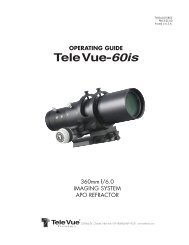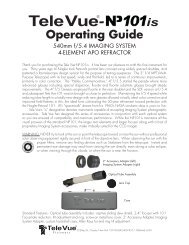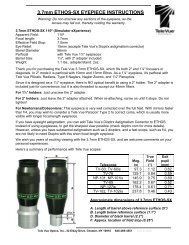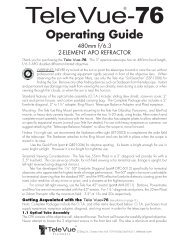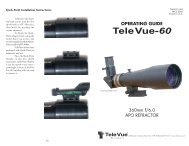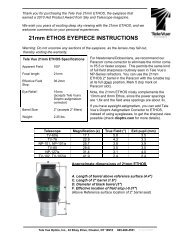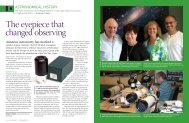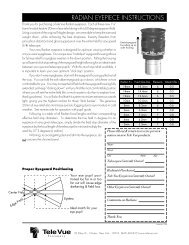comparing
Full Review - TeleVue Optics
Full Review - TeleVue Optics
- No tags were found...
You also want an ePaper? Increase the reach of your titles
YUMPU automatically turns print PDFs into web optimized ePapers that Google loves.
TELE VUE ETHOS<br />
ETHOS SPECIFICATIONS<br />
21mm 13mm 17mm 10mm 8mm 6mm<br />
Focal Length: 21mm 13mm 17mm 10mm 8mm 6mm<br />
Apparent Field: 100° 100º 100° 100° 100° 100°<br />
Eye Relief: 15mm 15mm 15mm 15mm 15mm 15mm<br />
Effective Field Stop Diameter: 36.2mm 22.3mm 29.6mm 17.7mm 13.9mm 10.4mm<br />
Barrel Size: 2" 2"/1 1 /4" 2" 2"/1 1 /4" 2"/1 1 /4" 2"/1 1 /4"<br />
Weight: 2.25 lb 1.3lbs. 1.55 lbs 17.7 oz 15.2 oz 15.5 oz<br />
(All accept DIOPTRX eyesight astigmatism corrector)<br />
of green and violet, but looking at the lenses<br />
straight on, they almost seemed to disappear.<br />
Through the scope at night, there is no glare,<br />
reflections, or ghosting. I spent a good deal<br />
of time <strong>comparing</strong> my 16-mm T5 Nagler to<br />
the 17-mm Ethos, as well as the 8-mm and<br />
10-mm Ethos to my 9-mm T6 Nagler. I’d<br />
read much about the newer coatings and glass<br />
in the Ethos and differences compared to Naglers,<br />
so I decided to do my own comparison.<br />
Indeed, the Ethos coatings have some different<br />
characteristics than Naglers. Stars appear<br />
slightly whiter, but star color is still easily seen<br />
(even through my somewhat color challenged<br />
eyes). The vibrant whites and cooler view<br />
don’t obscure fine details; rather, it makes<br />
them easier to distinguish. When viewing low<br />
contrast features on Jupiter’s disk one night,<br />
I felt that the views through the Ethos were<br />
ever so slightly better than that through the<br />
Naglers and other eyepieces I was using. Objects<br />
with low contrast simply stand out<br />
slightly better through the Ethos. When I<br />
compared the 6-mm Ethos to a 6-mm widefield<br />
(brand not mentioned to protect the innocent),<br />
I was shocked at the difference.<br />
Some say that wide-field eyepieces aren’t<br />
meant for planetary observing; those people<br />
need to try an Ethos!<br />
I spent a few more moonless nights observing<br />
through an 80-mm f/6 “ED” refractor.<br />
While this telescope has great optics, it<br />
does show a touch of color, so I didn’t evaluate<br />
that when viewing through this scope.<br />
Through the refractor, I noticed a vague<br />
touch of field curvature if I REALLY looked<br />
for it. This was seen through all of the Ethos,<br />
and when <strong>comparing</strong> it to the Naglers, I noticed<br />
that the slight field curvature in the<br />
Ethos was in the last 10 or so degrees closest<br />
to the field stop. With the Naglers narrower<br />
AFOV, it wasn’t seen in them at all. Still, I<br />
really had to look for it in the Ethos. At first<br />
glance, stars looked sharp at the edge when<br />
compared to those in the center of field: upon<br />
closer observation, I found just a slight tweak<br />
of the fine focus knob brought them into true<br />
focus. Ethos are flat-field eyepieces and<br />
because they show more true field of view at<br />
a given magnification some might see field<br />
curvature in a telescope that other narrower<br />
eyepieces won’t show. In my Paracorr<br />
corrected Dob stars were sharply focused to<br />
the edge of the field. In my 80-mm f/6 refractor,<br />
I did notice a touch of field curvature,<br />
most notably with the longer focal length<br />
Ethos. I’ve also noticed that as I’ve gotten<br />
older, my eyes don’t accommodate for field<br />
curvature like they used to. So some<br />
observer’s eyes may be able to accommodate<br />
for it better than mine do.<br />
One thought I had when <strong>comparing</strong> the<br />
Ethos with my current eyepiece arsenal is<br />
how one could get by with fewer eyepieces<br />
when using the Ethos exclusively.The price of<br />
the Tele Vue Ethos has been a topic of<br />
discussion, but if you’re only buying 3<br />
eyepieces instead of 6, the price isn’t much of<br />
a factor to consider. It reminds me of the time<br />
I bought a telescope and got a half dozen<br />
eyepieces (with a free case!) for an extra hundred<br />
bucks. I quickly learned that quality was<br />
better than quantity when it comes to eyepieces,<br />
because many of the cheap plossls I<br />
got for “such a deal” were nearly unusable.<br />
The Ethos can’t be compared to such<br />
eyepieces, of course, but even compared to<br />
Naglers, one could certainly get by with fewer<br />
eyepieces in their case.<br />
In conclusion, I think it’s obvious that<br />
the bar has been raised immensely, and likely<br />
to a similar extent thatTele Vue raised it when<br />
they released the very first Nagler so many<br />
years ago. It really is a complete sensory overload<br />
the first time to see that 100 degree<br />
AFOV, and every time thereafter when you<br />
switch back to an Ethos after using a narrower<br />
field eyepiece. Correction is nearly perfect<br />
in any scope, and Ethos even work well<br />
as planetary eyepieces. With the introduction<br />
of the 21-mm, Dob owners, especially those<br />
in light polluted skies, will appreciate the<br />
smaller exit pupil and wideTFOV.The wider<br />
AFOV of the Ethos allow the observer to use<br />
more magnification while still maintaining a<br />
wide TFOV. With the parameters of these<br />
eyepieces, the Ethos are positively revolutionary<br />
in terms of design and weight. If you<br />
like wide-field eyepieces, you really have<br />
GOT to own the Ethos; it’s not just widefield,<br />
super-wide, or ultra-wide; it’s something<br />
we might need a new name to describe (hyperultramegawide?).<br />
Or we could just agree<br />
withTele Vue and simply call it “The Majesty<br />
Factor”. I’m here to tell you that it’s a real phenomenon.<br />
As I was wrapping up my review on the<br />
Ethos line, I got the news that I’d be receiving<br />
the new 21mm Ethos as well. Though I<br />
ended up not having quite as much time with<br />
it under the stars as the rest of the Ethos, I<br />
probably could’ve squeezed it into the article.<br />
However, I feel that it’s such a special eyepiece<br />
that it deserves its entirely own article and review.<br />
So look for a comprehensive write-up<br />
of the brand new 21mm Ethos in the next<br />
issue of Astronomy Technology Today.<br />
Astronomy TECHNOLOGY TODAY 38




